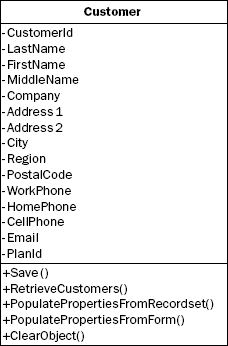14.4. Building the Class Module for the Objects
Next, turn your attention to writing the code that will implement the desired features of your Customer Service application. VBA code can be written in various places, such as class modules that are independent or associated with a form, as well as in standard modules. Just as in the prior case study, you will create the custom class module first, then the standard modules, and finally the code for the forms to call the other modules. An example of how the Project Explorer will look in the Visual Basic Editor when you're finished is shown in Figure 14-25.
Figure 14.25. Figure 14-25

In this Customer Service application, you create one custom class module that will store the values for the current Customer.
An object diagram for the Customer class is shown in Figure 14-26.
Figure 14.26. Figure 14-26

The properties correspond to the data elements on the View/Manage Customer Accounts form for the most part, except that the values for the Plan History records are not shown here. The methods represent various actions that should be taken on the object. You will also write numerous other procedures that are not in the class module, as you will see later.
Try It Out: Building the clsCustomer ClassLet's get started and build the clsCustomer ... |
Get Beginning Access™ 2007 VBA now with the O’Reilly learning platform.
O’Reilly members experience books, live events, courses curated by job role, and more from O’Reilly and nearly 200 top publishers.

